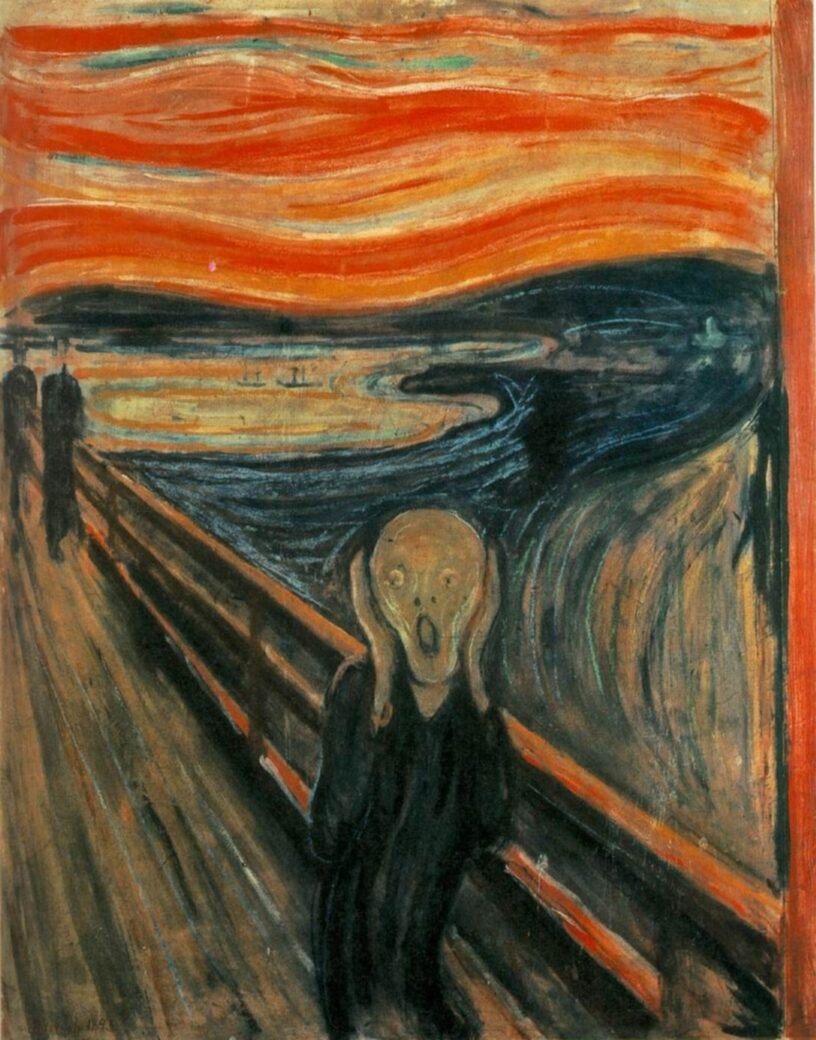The Scream is maybe the noisiest way in which pastel has ever been put to cardboard. The painting depicts a form bracing its ears against a noise bellowing out across the Norwegian landscape. Famously a self-portrait, the lantern-jawed terror can be explained away as the Norwegian author Edvard Munch reckoning with his neurasthenia, a vaguely defined mental condition tied to sleep and emotional disturbances. However, a poem scrawled in slanted red ink along the bottom of the original frame hints at a more existential threat. It describes Munch on an evening stroll through Ekeberg, a neighborhood just outside of Oslo. Passing a “blue-black” fjord on his right, Munch paused suddenly and let his two other friends walk ahead as he “stayed behind – quaking with Angst.” The Scream depicts the moment a chill ran through his blood: what he described as “the great Scream in Nature.”
In line with the motives of the expressionist movement, Munch’s masterpiece inspires the same feelings of angst and isolation in its observer. The sharp lines of the walkway direct the observer to the disinterest exhibited by the frame’s two other occupants. Utterly alone, the subject melts into the swirling chaos of the environment, isolated by terror. Many pieces of media have tried to express the same distress felt by the painting’s subject, but few show the viewer how “the great Scream in Nature” might have sounded. However, 114 years after the creation of The Scream, a show airing on basic cable offered a unique answer.
Munch’s abrasive proto-expressionist work was particularly shocking to a world undergoing the second industrial revolution, mirroring the anxiety rampant throughout a world reckless with innovation. Modern noise evolved from the hum of the radio to the roar of a jet engine in half a century. Media evolved from stills to moving stills and then to moving shouting stills. Still, nothing screams louder than anxiety. It isolates and allows the calmness in the world to implode inwards. Matthew Weiner’s award-winning drama, Mad Men, recognizes this truth and uses its creative sound design to express the anxiety ingrained at its core.
Break-neck-paced dramas like the Safdie brothers’ Uncut Gems and Emma Seligman’s Shiva Baby explode with bombastic synthwave and violent string arrangements, but they lack the haunting dread of The Scream. It’s the feeling that something is just a little off in a big way: like you forgot to turn off a burner. In Mad Men, this dread builds steadily through the decade, from the assassination of JFK to the nuclear arms race and the rise of the civil rights movement. It lives twitching in the background, cocked and loaded to blow apart the lives of characters strung together with cigarettes and lies. This constant anxiety is defined by its isolating nature. It feels like nobody wants to talk about how crazy the world is; like nobody else hears the scream. The show vocalizes this scream with a unique sound design that simmers in the background. It’s a wall of typewriters’ dings, sizzling cigarette buds, and wheezing horns always just off-screen and always just a little too loud. The most anxiety-ridden moments, like when protagonist Don Draper’s history as a military deserter and an identity thief is revealed, aren’t scored by music; they’re scored by layers of this noise, building until almost unbearable. The viewer, unable to place their discomfort, feels like The Scream’s subject as his two friends walk ahead, unburdened by “the great Scream in Nature.”
But how could the luxurious excess of an Ad Man’s lifestyle or the excessive beauty of a bloody sunset over the Norwegian fjord possibly inspire unhappiness? It’s the consideration of how happy you feel in that moment and the curiosity of how you could ever possibly feel happier. It’s realizing that the world is too sprawling to ever experience everything you want to experience or feel everything you want to feel. A similar drive for happiness pushes the cast of Mad Men to sex, drugs, affairs, divorce, blackmail, and ultimately unhappiness. But the viewer always empathizes with this drive because the show is shrouded in the constant noise of an expanding world that might leave its occupants behind. The Scream shows the world through the eyes of anxiety, while Mad Men paints an anxious world with noise. However, both pieces of media successfully reflect the anxiety of their time because they place the viewer into a world that either feels too big to understand or sounds too aggressive to be reasoned with.




Leave a Reply